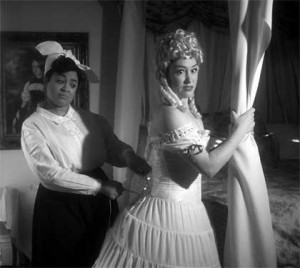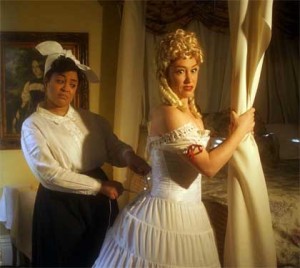Play (2011)
by Lynn Nottage
Directed by Summer L. Williams
March 29 – April 27, 2013
With Kami Rushell Smith (Vera Stark), Hannah Husband (Gloria Mitchell), Terrell Donnell Sledge (Leroy Barksdale/ Herb), Lyndsay Allyn Cox (Lottie McBride/ Carmen Levy-Green), Kris Sidberry (Anna Mae Simpkins/ Afua Assata Ejobo), Kelby T. Akin (Mr. Slasvick/ Brad Donovan), Gregory Balla (Maximililian Von Oster/ Peter Rhys-Davies)

Hannah Husband as Gloria MitchelL
in “By The Way, Meet Vera Stark”
Photo by Johnathan Carr
Courtesy Lyric Stage Company of Boston
Vera Stark (Kami Rushell Smith), an African-American woman, starts out as the maid of white Hollywood star Gloria Mitchell (Hannah Husband) and aspires to a career in movies herself. Accompanied by a couple of African-American women friends, Lottie McBride (Lyndsay Allyn Cox) and Anna Mae Simpkins (Kris Sidberry), who also are trying to find their ways into the industry, Vera fantasizes about, then militates towards, getting a foot in the door.
The first act of this play takes place in 1933, at a time when a black actress in Hollywood might aspire to play a maid in a film, but not much more. It details the machinations surrounding the arrangements for the making of a film starring Vera’s employer, Gloria Mitchell, and the associated opportunities which evolve for Vera.
The second act of the play takes place in 2003, at a symposium about the roles that black actresses played at the time the first act takes place, and invokes a setting in 1973 depicting a TV show on which Vera Stark had appeared. The 2003 symposium participants ruminate about the nature of those early film roles and what they signified for African-American women, as the action flips back and forth from the enacted TV show to the scene of the symposium.
The first act of this work is quite effective in communicating a sense of the indignities and challenges posed to the black women who aspired at the time to enter the movies. The depicted relation between Vera Stark and her boss, Gloria Mitchell – to whom, it seems from a couple of lines of dialogue, she might be a cousin of some sort – is kind of endearing. The challenges shared among the three black women is nicely portrayed, and one gets, from this, a real sense of the era and of the challenges.

Hannah Husband as Gloria MitchelL
in “By The Way, Meet Vera Stark”
Photo by Johnathan Carr
Courtesy Lyric Stage Company of Boston
The second act is more problematic. I do not know whether the main issue is in Nottage’s writing or in Williams’ direction, but the combination of the two, in this case, produced a result that did not work as well for me. I think the attempt, both through writing and direction, was to be satirical, but the staged outcome, in both the 2003 symposium and in the 1973 TV show, appeared somewhat more coarse than satirical, and less effective than it might have been. What, to the playwright, perhaps seemed an interesting contextualization at the time of writing came across as something of a disjointed appendage.
At the very end, however, there is a coda which returns to 1933, and it is poignant, significant and delightful. It is so subtly and beautifully written and enacted that it almost saves the play from the foregoing problems. It depicts a beautiful interaction, in between film takes, between Vera Stark and Gloria Mitchell, and evokes something important about the way drama, film, and, for that matter, all of art, carry and convey meaning. It is a short moment, but wonderful in its own right.
– BADMan
Leave a Reply